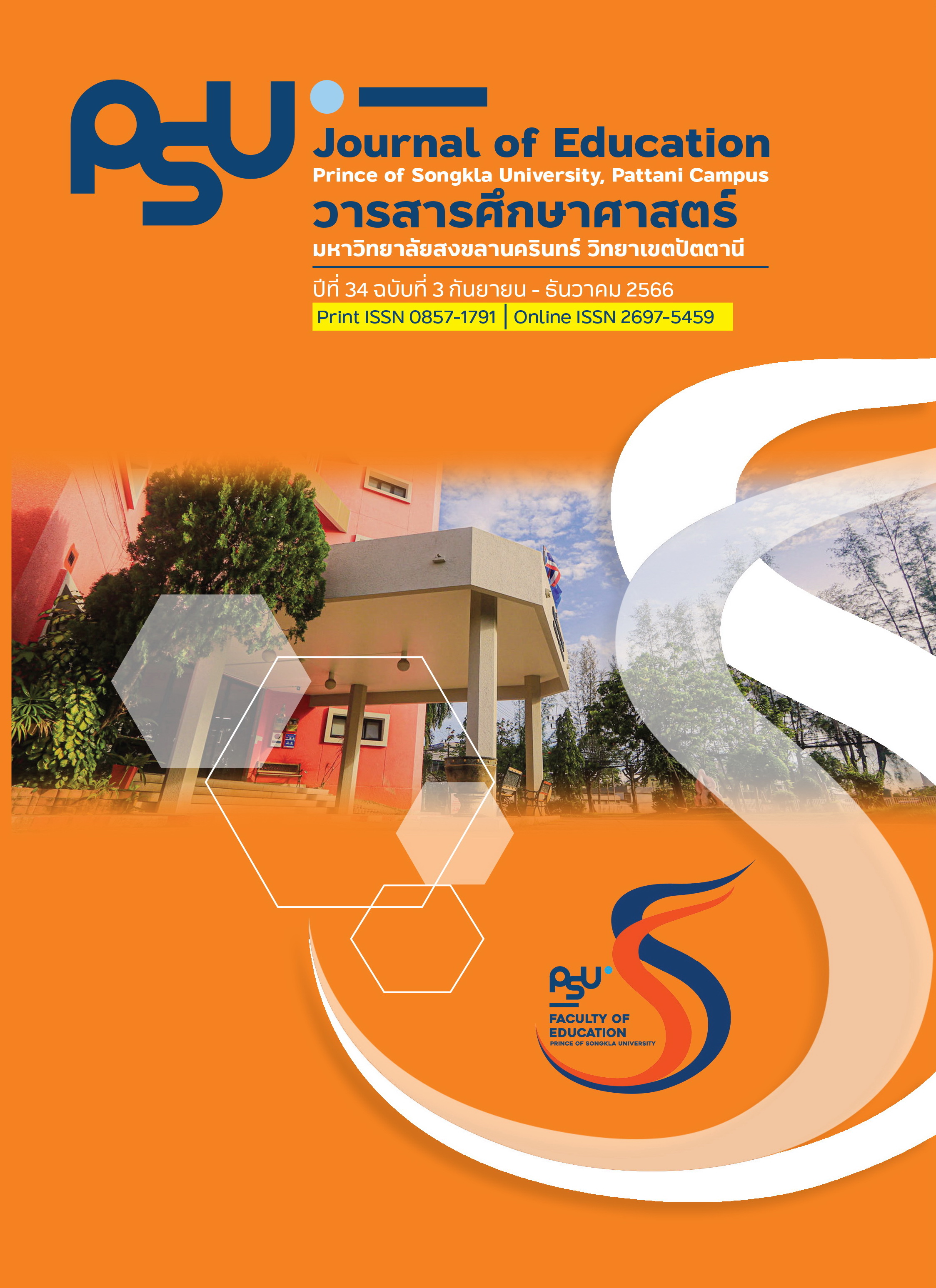ผลของการบูรณาการจัดการเรียนรู้สะเต็มศึกษาร่วมกับโครงงาน เป็นฐานต่อการพัฒนาความคิดสร้างสรรค์และการคิดอย่างมีวิจารณญาณของนิสิตครูสาขาเคมี
Main Article Content
บทคัดย่อ
งานวิจัยนี้มีวัตถุประสงค์เพื่อศึกษาผลของการบูรณาการสะเต็มศึกษาร่วมกับการเรียนรู้โดยใช้โครงงานเป็นฐาน เพื่อพัฒนาความคิดสร้างสรรค์และการคิดอย่างมีวิจารณญาณของนิสิตครูภายใต้หัวข้อ “นักออกแบบขยะผู้ใช้ขยะเป็นแรงบันดาลใจเพื่อการสร้างสรรค์ผลิตภัณฑ์ใหม่” ซึ่งเป็นหัวข้อที่นิสิตค้นพบและต้องการแก้ไขปัญหาขยะจากชุมชนย่านเมืองเก่าสงขลา กลุ่มตัวอย่างได้แก่ นิสิตครูเคมี คณะศึกษาศาสตร์ มหาวิทยาลัยทักษิณ วิทยาเขตสงขลา จำนวน 34 คน โดยวิธีการเลือกแบบเจาะจง งานวิจัยนี้เป็นงานวิจัยเชิงคุณภาพโดยมีเครื่องมือที่ใช้ในการวิจัยคือ 1) Creativity Product Analysis Matrix (CPAM) 2) Paul-Elder Critical Thinking Framework และ 3) แบบสังเกต
ชั้นเรียน
ผลการวิจัยพบว่า การจัดการเรียนรู้ตามแนวทางสะเต็มศึกษาร่วมกับการเรียนรู้โดยใช้โครงงานเป็นฐาน สามารถส่งเสริมให้นิสิตครูเคมีมีความคิดสร้างสรรค์และการคิดอย่างมีวิจารณญาณในทุก ๆ มิติ โดยนิสิตครูเคมีมีคะแนนเฉลี่ยในมิติของความคิดสร้างสรรค์คิดเป็นร้อยละ 72 ซึ่งอยู่ในเกณฑ์ระดับดี นอกจากนี้นิสิตครูเคมีมีคะแนนเฉลี่ยในมิติของการคิดอย่างมีวิจารณญาณเท่ากับ 3.3 ของคะแนนเต็ม 4.0 ซึ่งอยู่ในเกณฑ์ระดับนักคิดขั้นสูง ผลจากการวิจัยบ่งชี้ว่าการจัดการเรียนรู้ตามแนวทางสะเต็มศึกษาร่วมกับการเรียนรู้โดยใช้โครงงานเป็นฐานส่งผลดีต่อการพัฒนาความคิดสร้างสรรค์และการคิดอย่างวิจารณญาณของนิสิตครู ซึ่งการค้นพบนี้คาดว่าจะช่วยให้ผู้สอนกลับมาทบทวนใหม่ว่านิสิตครูจะได้รับประโยชน์อย่างไรจากการจัดการเรียนรู้ด้วยสะเต็มศึกษาร่วมกับการเรียนรู้โดยใช้โครงงานเป็นฐานและปรับโครงสร้างกลยุทธ์การสอนเพื่อให้บรรลุการเรียนรู้ที่เน้นผู้เรียนเป็นสำคัญ
Article Details

อนุญาตภายใต้เงื่อนไข Creative Commons Attribution-NonCommercial 4.0 International License.
เอกสารอ้างอิง
Altan, E. B., & Tan, S. (2021). Concepts of creativity in design based learning in stem education. International Journal of Technology and Design Education, 31, 503–529.
Baharin, N., Kamarudin, N., & Manaf, U. K. (2018). integrating stem education approach in enhancing higher order thinking skills. International Journal of Academic Research in Business and Social Sciences, 87, 810–822.
Besemer, S. P. (1998). creative product analysis matrix: testing the model structure and a comparison among products -Three novel chairs. Creativity Research Journal, 11(4), 333-346.
Burrows, A. C., Breiner, J. M., Keiner, J., & Behm, C. (2014). Biodiesel and integrated stem: vertical alignment of high school biology/biochemistry and chemistry. Journal of Chemical Education, 91, 1379–1389.
Besemer, S. P., & Treffinger, D. (1981). Analysis of creative products: Review and synthesis. The Journal of Creative Behavior, 15(3), 158–178.
Breiner, J. M., Johnson, C. C., Harkness, S. S., & Koehler, C. M. (2012). What is STEM? A discussion about conceptions of stem in education and shelly sheats harkness partnerships. School Science and Mathematics, 112(1), 3-11.
Chonkaew, P., Sukhummek, B., & Faikhamta, C. (2016). Development of analytical thinking ability and attitudes towards science learning of grade-11 students through science technology engineering and mathematics (stem education) in the study of stoichiometry. Chemistry Education Research and Practice, 17, 842-861.
Darling-Hammond, L., Flook, L., Cook-Harvey, C., Barron, B., & Osher, D. (2019). Implications for educational practice of the science of learning and development. Applied Developmental Science, 1-44.
Fan, S. C., & Yu, K. C. (2017). How an integrative stem curriculum can benefit students in engineering design practices. International Journal of Technology and Design Education, 27, 107-129.
Hafni, R. N., Herman, T., Nurlaelah, E., & Mustikasari, L. (2020). The Importance of science, technology, engineering, and mathematics (STEM) education to enhance students’ critical thinking skill in facing the industry 4.0. Journal of Physics: Conference Series, 1521(4), 042040.
Han, S., Capraro, R., & Capraro, M. M. (2014). How science, technology, engineering, and mathematics (STEM) project-based learning (PBL) affects high, middle, and low achievers differently: The impact of student factors on achievement. International Journal of Science and Mathematics Education, 13(5), 1089–1113.
Han, S., Rosli, R., Capraro, M. M., & Capraro, R. M. (2016). The effect of science, technology, engineering and mathematics (STEM) project-based learning (PBL) on students’ achievement in four mathematics topics. Journal of Turkish Science Education, 13(special), 3-29.
Hanif, S., Wijaya, A. F. C., & Winarno, N. (2019). Enhance students’ creativity through STEM projectbased learning. Journal of Science Learning, 2(2), 50-57.
Haryadi, R., & Pujiastuti, H. (2022). enhancing pre-service physics teachers' higher-order thinking skills through STEM-PjBL model. International Journal of STEM Education for Sustainability, 2(2), 156-171.
Lou, S. J., Chou, Y. C., Shih, R. C., & Chung, C. C. (2017). A Study of creativity in CaC2 steamshipderived stem project-based learning. EURASIA Journal of Mathematics Science and Technology Education, 13(6), 2387–2404.
Mater, N. R., Hussein, M. J. H., Salha, S. H., Draidi, F. R., Shaqour, A. Z., Qatanani, N., & Affouneh, S. (2020). The effect of the integration of STEM on critical thinking and technology acceptance model. Educational Studies, 1-17.
Meikiasari, M., Rahmawati, Y., Delina, M., & Fitriani, E. (Eds.) (2020). The implementation of STEM learning on creative-critical thinking styles (study on pre-service physics teacher). AIP Conference Proceedings. AIP publishing. https://doi.org/10.1063/5.0041991
Nakano, T. D. C., & Wechsler, S. M. (2018). Creativity and innovation: Skills for the 21st century. Estudos de Psicologia (Campinas), 35(3), 237-246.
OECD. (2018). Pisa 2018 result combined executive summaries volume I, II & III. https://www.oecd.org/pisa/Combined_Executive_Summaries_PISA_2018.pdf
Paul, R. W., & Elder, L. (2009). The miniature guide to critical thinking concepts & tools. (6th ed.). Rowman & Littlefield Publishers: Washington, DC.
Retnaningsih, R., Kindiasari, A., & Nurdiyanto, H. (2020). Blended learning learning model to improve critıcal thinking skills. Journal of Critical Reviews, 7(19), 2289–2292.
Reynders, G., Lantz, J., Ruder, S. M., Stanford, C. L., & Cole, R. S. (2020). Rubrics to assess critical thinking and information processing in undergraduate STEM courses. International Journal of STEM Education, 7, 2-15.
Saien, S., Tee, T. K., Yunos, J. M., & Yee, H. M. (2019). Thinking style pattern among design and technology teachers in Malaysia. Journal of Technical Education and Training, 11(3), 43–48.
Siew, N. M., Amir, N., & Chong, C. L. (2015). The perceptions of pre-service and in-service teachers regarding a project-based STEM approach to teaching science. SpringerPlus, 4(1), 1-20.
Sumarni, W., & Kadarwati, S. (2020). Ethno-stem project-based learning: Its impact to critical and creative thinking skills. Journal Pendidikan IPA Indonesia, 9(1), 11-21.
Wattanakit, S., & Khwunsuwan, W. (2021). Adding value to waste for decoration products: Prototype communities in Khaoroopchang Municipality, Songkhla Province Thailand. Journal of Architecture, Design and Construction, 3(2), 13-27.
Wechsler, M. S., Saiz, C., Rivas, S. F., Vendramini, C. M. M., Almeida, L. S., Mundim, M. C., & Franco, A. (2018). Creative and critical thinking: Independent or overlapping components? Thinking Skills and Creativity, 27, 114-122.


